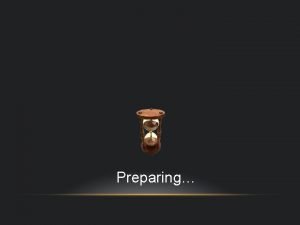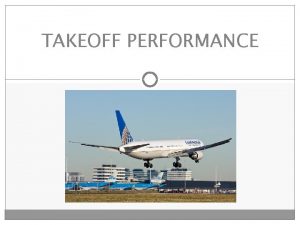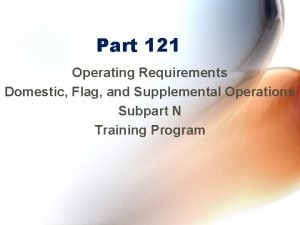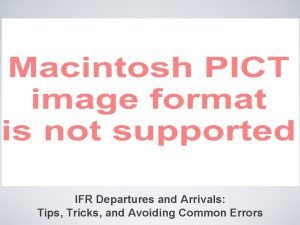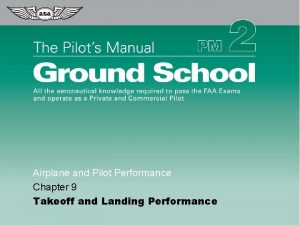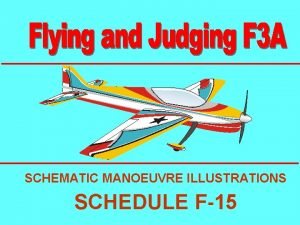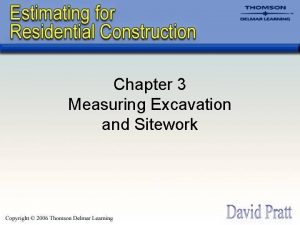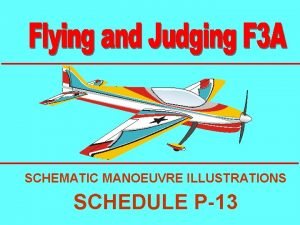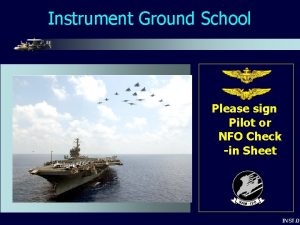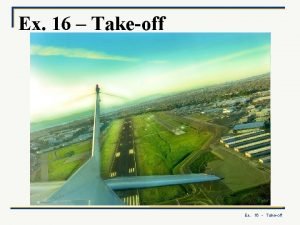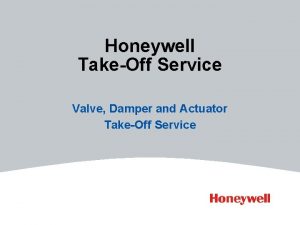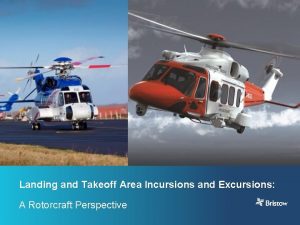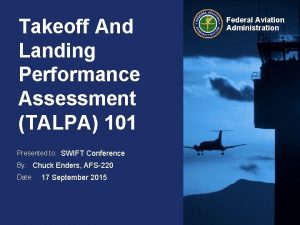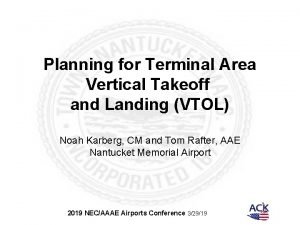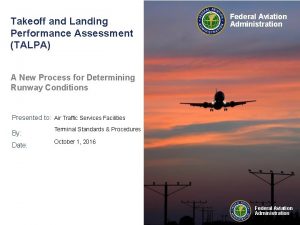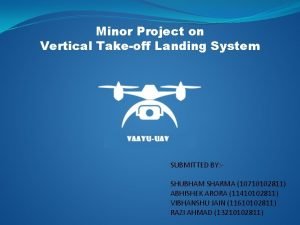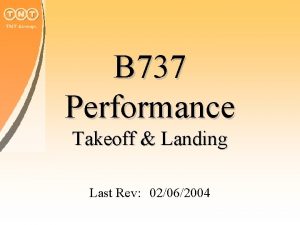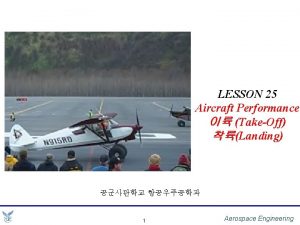All Weather Takeoff and Landing HPA Group 11

















- Slides: 17

All Weather Takeoff and Landing HPA Group 11 -02 -2006 Brett Mather Ryan Beach

All weather takeoff and landing is broken up into the following sections: • Requirements • Technology

All-Weather Terminal Area (ATWA) Operations Basic Types of AWTA approach and landing operations 1. Visual Approach • Aircraft is being operated in normal visual flight rules (VFR) and normal instrument flight rules (IFR) 2. Instrument Approach • Instrument approach procedures permit descent in IFR conditions to allow for a safe landing. • Standard instrument approaches include International Civil Aviation Organization (ICAO), standard Navigation Aids (ILS, MLS, VOR/DME, NDB), as well as approaches based on ATC radar services.

All-Weather Terminal Area (ATWA) Operations (cont’d) Requirements for VFR (FAR Part 121. 649) 1. Regardless of ATC clearance, no pilot may takeoff or land when the reported ceiling and visibility is less than: • Day Operation: 1, 000 ft ceiling and 1 mile visibility • Night Operation: 1, 000 ft ceiling and 2 mile visibility 2. Where local surface visibility restrictions exist (smoke, dust, blowing snow, etc. ) the visibility for day and night operations may be reduced to ½ mile provided all flight beyond 1 mile from the airport can be accomplished outside of the surface visibility restriction.

All-Weather Terminal Area (ATWA) Operations (cont’d) Requirements for IFR (FAR Part 121. 651) 1. Prior to takeoff, the pilot must obtain ATC clearance and must pass weather conditions specified in operation specifications manual take-off minimums. 2. Prior to the final approach segment of the instrument approach, the destination airport must issue a weather report with above-minimum weather conditions for the pilot to pass the final approach fix. 3. If the pilot has entered the approach and an updated weather with belowminimum weather conditions, the pilot may continue until decision height. • At the DH, the pilot may continue to touch down if: Ø A normal touchdown will occur within the touchdown zone. Ø The flight visibility agrees with the instrument approach procedure being used Ø In a category I approach, one of the following visual references must be identified:

All-Weather Terminal Area (ATWA) Operations (cont’d) Requirements for IFR (FAR Part 121. 651) (cont’d) • • • The threshold markings The threshold lights The runway end identifier lights The visual approach slope indicator • The approach light system • The touchdown zone or touchdown zone markings • The touchdown zone lights • The runway or runway markings • The runway lights

All-Weather Terminal Area (ATWA) Operations (cont’d) Categories of Instrument Approach Procedures Category Decision Runway Visual Height (DH, ft. ) Range (RVR, ft. ) Alert Height (AH, ft. ) Equipment allowed CAT I DH > 200 RVR > 1800 N/A CAT II 200 > DH > 100 RVR > 1200 N/A CAT IIIa 100 > DH RVR > 700 100 Fail-passive & fail -operational CAT IIIb 50 > DH 700 > RVR > 150 100 Fail-operational CAT IIIc landing has no limit on DH and RVR, but is currently unauthorized

Landing Requirements (military)

Technologies for All Weather Takeoff and Landing • Aircraft Design • Electronics • Runway Design

Aircraft Design • Stronger landing gear for rough landings • Landing gear swivel • First used on Boeing 747 -100 to accomplish tighter turns on the ramp but is consistently used for crosswind landings • Better tire design • Brighter aircraft lights with upgraded high intensity discharge (HID) bulbs • Example design problem associated with weather: Tail Dragger aircraft taxiing in a strong cross wind can cause the plane to weathervane due to the light weight tail with small force on the tail wheel. Michelin Tire Design

Electronics • Air Traffic control (ATC) • Better weather prediction and detailed weather reports • Pilots must be informed of landing conditions (wind speed/direction, runway surface conditions) • Auto-pilot can execute landings in conditions of poor visibility that would be impossible otherwise • Sophisticated systems can also execute landings in severe crosswind conditions • Technology to improve visibility • Fog defeating system converts signals from on-board sensors and airport navigational aids into a holographic image of the approaching runway, which is projected onto a glass screen between the pilot and the windshield.

Runway Design • Rain Snow/ice landing • Wet and icy runways are the leading cause of landing accidents worldwide • NASA Joint Winter Runway Friction Measurement Program developed for braking tests for aircraft and friction measurement ground vehicles in the U. S. and Canada • Landing Surface Quality Evaluation • Visual inspection to determine the type of contaminant (rain, snow, etc) and the extent of its coverage Grooved Runway • Thickness of contaminant • Friction Measurement • Lighting Systems (brightness can often be controlled by the pilot) • Chemical treatment for snow and ice (FPD (freezing point depressant) • Better runway surface (Grooved runway reduce hydroplaning based on research from NASA in 1968) • Some surfaces designed to retain anti icing chemicals Friction Measurement / Testing Device

Runway Design / Electronics • ISL (instrument landing system) • Primarily consists of two subsystems: one for lateral guidance (Localizer), one for vertical guidance (Glideslope or Glide. Path) • Marker beacons are used to measure how far until landing • All of these systems emit signals at different frequencies that are translated by electronics to determine the position of the aircraft ILS Localizer

Runway Design / Electronics • MLS (Microwave landing system) • Microwave landing system are all weather landing systems that are similar to ILS. • Fewer transmitter stations needed for MLS (usually a single box) • Approach Azimuth station, Elevation station, and Range Station MLS Elevation Azimuth Measurement Range

Electronics • WAAS / GPS (Wide Area Augmentation System / Global Positioning System • WAAS is a system that improves the accuracy of GPS from the original 4 -20 meter accuracy to a 2 -3 meter accuracy by removing error cause by the earths ionosphere • This system basically ended the development of MLS • Normal GPS is not accurate enough to land a plane but with WAAS capability it is now possible. • New techniques such as Differential GPS can be even more accurate (calibrates GPS by measuring known fixed locations)

Questions?

References • • • • • http: //www. faa. gov/library/manuals/examiners_inspectors/8400/media/volume 4/4_002 _02. pdf http: //www. risingup. com/fars/info/part 121 -651 -FAR. shtml http: //www. risingup. com/fars/info/part 121 -649 -FAR. shtml http: //en. wikipedia. org/wiki/IFR http: //www. centennialofflight. gov/essay/Government_Role/landing_nav/POL 14. htm http: //query. nytimes. com/gst/fullpage. html? res=9 C 0 CE 3 D 9163 DF 935 A 35753 C 1 A 966 958260 http: //www. airporttech. tc. faa. gov/safety/deice. asp http: //www. aa. washington. edu/courses/aa 410/2000_2001/templgana. htm http: //www. nasa. gov/centers/langley/news/factsheets/Groove_prt. htm http: //en. wikipedia. org/wiki/Instrument_Landing_System http: //www. tc. gc. ca/tdc/publication/tp 13361 e/13361 e. htm http: //en. wikipedia. org/wiki/Wide_Area_Augmentation_System http: //www. airmichelin. com/pdfs/C_ORION. PDF http: //stats. bls. gov/ocos 108. htm http: //en. wikipedia. org/wiki/Differential_GPS http: //www. physorg. com/news 65972803. html http: //www. answers. com/topic/instrument-flight-rules
 Koperasi wahida hpa berhad
Koperasi wahida hpa berhad Hpa display
Hpa display Hpaindonesia
Hpaindonesia Gross takeoff weight
Gross takeoff weight Part 121
Part 121 Standard takeoff minimums
Standard takeoff minimums Airplane landing distance graph
Airplane landing distance graph F-15 schematic
F-15 schematic Mode of measurement for excavation
Mode of measurement for excavation Pull push takeoff
Pull push takeoff Opencore takeoff delay
Opencore takeoff delay Cnaf 3710
Cnaf 3710 Koch chart density altitude
Koch chart density altitude Name all the lines
Name all the lines Weather symbols
Weather symbols Summer tongue twisters
Summer tongue twisters Poem of seasons
Poem of seasons Weather sunny rainy cloudy windy stormy
Weather sunny rainy cloudy windy stormy


